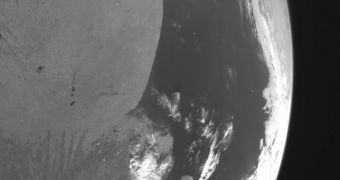Officials at the European Space Agency (ESA) announce that their Proba-2 Sun-watching satellite is currently keeping one of its eyes aimed at our planet. Using an advanced camera with an original and never-before-used design, the spacecraft is capable of obtaining wide-angle view of the planet with relative ease. The observations instrument itself is no larger than an espresso cup, representatives from the agency announce. They add that the Exploration Camera (X-Cam) is located on Proba-2's belly.
“X-Cam has a lot of components, capability and embedded intelligence we need to test. It’s really designed for exploration, which means we won’t know what scene we’re looking at, how far away it is and what exposure time is best. Rather than relying on trial and error, the camera’s intelligence makes sophisticated ‘automatic’ exposures, offering onboard quality control to deliver the best possible images,” explains Micro-Cameras & Space Exploration specialist Stephane Beauvivre.
“It also includes a lot of memory, which we need to check will stand up to prolonged radiation exposure. The opportunity to fly in this way aboard Proba-2 is very valuable. In our business, the only real technology demonstrations are in space – not guesses or ground tests but actual spaceflight,” the expert adds. As a whole, the Proba-2 mini-satellite carries no less than 17 separate technologies, all of which are new in space. Depending on how they behave during the course of this mission, ESA officials may choose to use them again on other, larger satellites, or simply shelve them and forget they ever existed.
Proba-2 is also the satellite that caught the largest geomagnetic storm of 2010 with its instruments. Astrophysicists classified the phenomenon as a low-intensity, or weak, event, even if this still implies temperatures averaging tens of millions of degrees Celsius. Though the event was of reduced intensity, it caused a massive front of charged particles, which headed straight for the Earth. The solar coronal mass ejection (CME) took place as the two celestial bodies were aligned, astronomers reveal. Proba-2 observed the event on April 3, at 11:54 CET.
Generally, solar flares are triggered by sudden impulsive releases of magnetic energy. When this happens, one of the most common outcomes is the generation of solar flares, though other phenomena may emerge as well. The recent explosion released about the same amount of energy that the entire planet consumes in a year, which is essentially nothing compared to larger events of the same class. The resulting waves of charged particles (radiation) spread through space at a speed of about 500 kilometers per second, and their vast majority slammed against our atmosphere.

 14 DAY TRIAL //
14 DAY TRIAL //